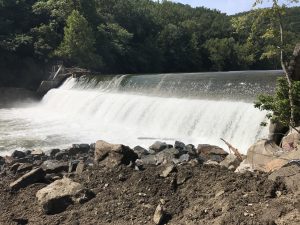Bloede Dam Removal Begins
Partnership Effort Restoring Patapsco River, Improving Public Safety
 Conservation leaders, federal and state officials, and other partners gathered today on the Patapsco River to celebrate the removal of Bloede Dam – an effort that has been a decade in the making, and will have major benefits for fisheries, public safety, recreation, and the health of the Chesapeake Bay.
Conservation leaders, federal and state officials, and other partners gathered today on the Patapsco River to celebrate the removal of Bloede Dam – an effort that has been a decade in the making, and will have major benefits for fisheries, public safety, recreation, and the health of the Chesapeake Bay.
“Water is life, and healthy rivers are absolutely vital to our health, economy, and communities,” said Bob Irvin, President of American Rivers. “Today, we’re celebrating a new chapter for the Patapsco and all of the people who depend on this river. This is one of the most significant dam removal and river restoration projects in the country. We applaud the exemplary leadership from the state of Maryland and the collaboration and dedication of many public and private partners.”
“Today marks a major milestone in the reclamation and restoration of the Patapsco River,” Maryland Department of Natural Resources Secretary Mark Belton said. “With the removal of Bloede Dam from within Patapsco Valley State Park, we return a river to its natural flow and state, enhance fish migration and passage, improve water quality in its banks and ultimately the Chesapeake Bay, and better protect and serve our guests and patrons. Many thanks to all of our partners and stakeholders, especially American Rivers.”
Bloede Dam has served no functional purpose for decades and has posed a serious public safety hazard in Patapsco Valley State Park. There have been a number of injuries and deaths, with at least nine dam-related deaths since the 1980s, the most recent of which occurred in June 2015. Keeping the dam in place also would have been costly to taxpayers — at least $1 million would have been needed for repairs to comply with Maryland dam safety requirements.
In addition to eliminating the public safety risk, dam removal will give a tremendous boost to the health of the river ecosystem, including fisheries critical to the food web of the Chesapeake Bay. Bloede Dam serves as the first barrier on the Patapsco River blocking migratory fish swimming to and from the bay. Its removal is the linchpin of a decades-long restoration effort that also included the removal of Simkins Dam (2010) and Union Dam (2011). Removal of Bloede Dam will restore more than 65 miles of spawning habitat for blueback herring, alewife, American shad, and hickory shad in the watershed, and more than 183 miles for American eel.
“The removal of Bloede Dam would not be possible without long-term partnerships among National Oceanic and Atmospheric Administration, the State of Maryland, and American Rivers,” said Stuart Levenbach, Chief of Staff for the National Oceanic and Atmospheric Administration. “This project exemplifies the multiple benefits of habitat restoration. Together, we will remove unnecessary and unsafe structures while enhancing the natural resiliency of the Patapsco River Valley to benefit local communities, and restore 65 miles of spawning habitat for species like herring, shad and eel.”
The benefits of the project extend beyond the river environment to coastal habitats, where sediment carried by the river will replenish marshes and beaches, making the coast more resilient to extreme storms.
“We’re proud to work with our partners to restore the natural flow of the Patapsco River,” said U.S. Fish and Wildlife Service Northeast Regional Director Wendi Weber. “Free-flowing rivers create healthier coastal habitats for migratory fish and other wildlife and enhance recreational opportunities and public safety for nearby communities. What’s good for nature is good for people, too.”
Since Hurricane Sandy struck the East Coast in 2012, the service has helped fund 30 coastal resilience projects in 11 states, using more than $100 million from the Disaster Relief Appropriations Act of 2013. Twelve dam removals have restored nearly 100 miles of river to their natural state.
Following the initial blast of explosives to breach the dam, crews will continue demolition work for the next three months. The site will remain closed to the public until July 2019.
Removal of Bloede Dam was made possible through a partnership of American Rivers, the Maryland Department of Natural Resources, Maryland Department of Transportation State Highway Administration, National Oceanic and Atmospheric Administration, U.S. Fish and Wildlife Service, the Friends of the Patapsco Valley State Park, as well as monitoring partners U.S. Geological Survey, Maryland Biological Stream Survey, Maryland Geological Survey and University of Maryland Baltimore County.
The total cost of the project is estimated at $17.3 million. Funding for the project has come from the Maryland Department of Natural Resources, MDOT SHA, NOAA, the National Fish and Wildlife Foundation, U.S. Fish and Wildlife Service, the Coca-Cola Foundation and Keurig-Green Mountain.

 1-888-373-7888
1-888-373-7888 233733
233733